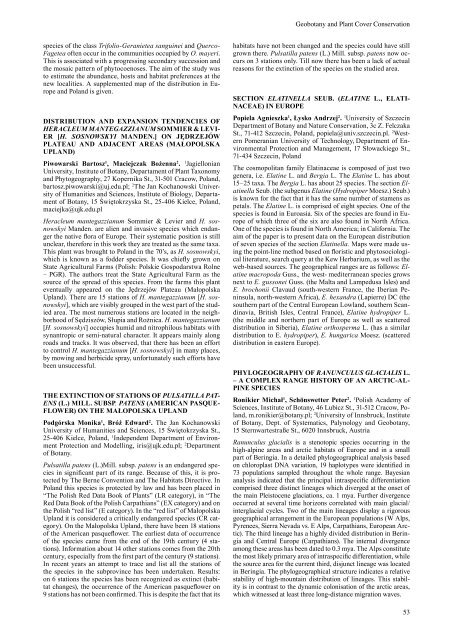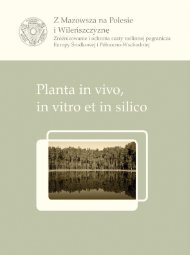acta societatis botanicorum poloniae - LV Zjazd Polskiego ...
acta societatis botanicorum poloniae - LV Zjazd Polskiego ...
acta societatis botanicorum poloniae - LV Zjazd Polskiego ...
You also want an ePaper? Increase the reach of your titles
YUMPU automatically turns print PDFs into web optimized ePapers that Google loves.
species of the class Trifolio-Geranietea sanguinei and Querco-<br />
Fagetea often occur in the communities occupied by O. mayeri.<br />
This is associated with a progressing secondary succession and<br />
the mosaic pattern of phytocoenoses. The aim of the study was<br />
to estimate the abundance, hosts and habitat preferences at the<br />
new localities. A supplemented map of the distribution in Europe<br />
and Poland is given.<br />
dISTrIBUTION ANd ExPANSION TENdENCIES OF<br />
herAcleum mAnteGAzziAnum SOMMIEr & LEVI-<br />
Er [h. sosnowskyi MANDEN.] oN JęDRZEJóW<br />
PLAtEAU AND ADJACENt AREAS (MAŁoPoLSKA<br />
UPLANd)<br />
Piwowarski Bartosz1 , Maciejczak Bożenna2 . 1Jagiellonian University, Institute of Botany, Departament of Plant Taxonomy<br />
and Phytogeography, 27 Kopernika St., 31-501 Cracow, Poland,<br />
bartosz.piwowarski@uj.edu.pl; 2The Jan Kochanowski University<br />
of Humanities and Sciences, Institute of Biology, Departament<br />
of Botany, 15 Świętokrzyska St., 25-406 Kielce, Poland,<br />
maciejka@ujk.edu.pl<br />
Heracleum mantegazzianum Sommier & Levier and H. sosnowskyi<br />
Manden. are alien and invasive species which endanger<br />
the native flora of Europe. Their systematic position is still<br />
unclear, therefore in this work they are treated as the same taxa.<br />
This plant was brought to Poland in the 70’s, as H. sosnowskyi,<br />
which is known as a fodder species. It was chiefly grown on<br />
State Agricultural Farms (Polish: Polskie Gospodarstwa Rolne<br />
– PGR). The authors treat the State Agricultural Farm as the<br />
source of the spread of this species. From the farms this plant<br />
eventually appeared on the Jędrzejów Plateau (Małopolska<br />
Upland). There are 15 stations of H. mantegazzianum [H. sosnowskyi],<br />
which are visibly grouped in the west part of the studied<br />
area. The most numerous stations are located in the neighborhood<br />
of Sędziszów, Słupia and Rożnica. H. mantegazzianum<br />
[H. sosnowskyi] occupies humid and nitrophilous habitats with<br />
synantropic or semi-natural character. It appears mainly along<br />
roads and tracks. It was observed, that there has been an effort<br />
to control H. mantegazzianum [H. sosnowskyi] in many places,<br />
by mowing and herbicide spray, unfortunately such efforts have<br />
been unsuccessful.<br />
THE ExTINCTION OF STATIONS OF PulsAtillA PAtens<br />
(L.) MILL. SUBSP. PAtens (AMErICAN PASqUEfLoWER)<br />
oN tHE MAŁoPoLSKA UPLAND<br />
Podgórska Monika1 , Bróż Edward2 . The Jan Kochanowski<br />
University of Humanities and Sciences, 15 Świętokrzyska St.,<br />
25-406 Kielce, Poland, 1Independent Department of Environment<br />
Protection and Modelling, iris@ujk.edu.pl; 2Department of Botany.<br />
Pulsatilla patens (L.)Mill. subsp. patens is an endangered species<br />
in significant part of its range. Because of this, it is protected<br />
by The Berne Convention and The Habitats Directive. In<br />
Poland this species is protected by law and has been placed in<br />
“The Polish Red Data Book of Plants” (LR category), in “The<br />
Red Data Book of the Polish Carpathians” (EX category) and on<br />
the Polish “red list” (E category). In the “red list” of Małopolska<br />
Upland it is considered a critically endangered species (CR category).<br />
On the Małopolska Upland, there have been 18 stations<br />
of the American pasqueflower. The earliest data of occurrence<br />
of the species came from the end of the 19th century (4 stations).<br />
Information about 14 other stations comes from the 20th<br />
century, especially from the first part of the century (9 stations).<br />
In recent years an attempt to trace and list all the stations of<br />
the species in the subprovince has been undertaken. Results:<br />
on 6 stations the species has been recognized as extinct (habitat<br />
changes), the occurrence of the American pasqueflower on<br />
9 stations has not been confirmed. This is despite the fact that its<br />
Geobotany and Plant Cover Conservation<br />
habitats have not been changed and the species could have still<br />
grown there. Pulsatilla patens (L.) Mill. subsp. patens now occurs<br />
on 3 stations only. Till now there has been a lack of actual<br />
reasons for the extinction of the species on the studied area.<br />
SECTION elAtinellA SEUB. (elAtine L., ELATI-<br />
NACEAE) IN EUrOPE<br />
Popiela Agnieszka 1 , Łysko Andrzej 2 . 1 University of Szczecin<br />
Department of Botany and Nature Conservation, 3c Z. Felczaka<br />
St., 71-412 Szczecin, Poland, popiela@univ.szczecin.pl. 2 Western<br />
Pomeranian University of Technology, Department of Environmental<br />
Protection and Management, 17 Słowackiego St.,<br />
71-434 Szczecin, Poland<br />
The cosmopolitan family Elatinaceae is composed of just two<br />
genera, i.e. Elatine L. and Bergia L. The Elatine L. has about<br />
15– 25 taxa. The Bergia L. has about 25 species. The section Elatinella<br />
Seub. (the subgenus Elatine (Hydropiper Moesz.) Seub.)<br />
is known for the fact that it has the same number of stamens as<br />
petals. The Elatine L. is comprised of eight species. One of the<br />
species is found in Euroasia. Six of the species are found in Europe<br />
of which three of the six are also found in North Africa.<br />
One of the species is found in North America; in California. The<br />
aim of the paper is to present data on the European distribution<br />
of seven species of the section Elatinella. Maps were made using<br />
the point-line method based on floristic and phytosociological<br />
literature, search query at the Kew Herbarium, as well as the<br />
web-based sources. The geographical ranges are as follows: Elatine<br />
macropoda Guss., the west- mediterranean species grows<br />
next to E. gussonei Guss. (the Malta and Lampedusa Isles) and<br />
E. brochonii Clavaud (south-western France, the Iberian Peninsula,<br />
north-western Africa), E. hexandra (Lapierre) DC (the<br />
southern part of the Central European Lowland, southern Scandinavia,<br />
British Isles, Central France), Elatine hydropiper L.<br />
(the middle and northern part of Europe as well as scattered<br />
distribution in Siberia), Elatine orthosperma L. (has a similar<br />
distribution to E. hydropiper), E. hungarica Moesz. (scattered<br />
distribution in eastern Europe).<br />
PHYLOGEOGrAPHY OF rAnunculus GlAciAlis L.<br />
– A COMPLEx rANGE HISTOrY OF AN ArCTIC-AL-<br />
PINE SPECIES<br />
Ronikier Michał 1 , Schönswetter Peter 2 . 1 Polish Academy of<br />
Sciences, Institute of Botany, 46 Lubicz St., 31-512 Cracow, Poland,<br />
m.ronikier@botany.pl; 2 University of Innsbruck, Institute<br />
of Botany, Dept. of Systematics, Palynology and Geobotany,<br />
15 Sternwartestraße St., 6020 Innsbruck, Austria<br />
Ranunculus glacialis is a stenotopic species occurring in the<br />
high-alpine areas and arctic habitats of Europe and in a small<br />
part of Beringia. In a detailed phylogeographical analysis based<br />
on chloroplast DNA variation, 19 haplotypes were identified in<br />
73 populations sampled throughout the whole range. Bayesian<br />
analysis indicated that the principal intraspecific differentiation<br />
comprised three distinct lineages which diverged at the onset of<br />
the main Pleistocene glaciations, ca. 1 mya. Further divergence<br />
occurred at several time horizons correlated with main glacial/<br />
interglacial cycles. Two of the main lineages display a rigorous<br />
geographical arrangement in the European populations (W Alps,<br />
Pyrenees, Sierra Nevada vs. E Alps, Carpathians, European Arctic).<br />
The third lineage has a highly divided distribution in Beringia<br />
and Central Europe (Carpathians). The internal divergence<br />
among these areas has been dated to 0.3 mya. The Alps constitute<br />
the most likely primary area of intraspecific differentiation, while<br />
the source area for the current third, disjunct lineage was located<br />
in Beringia. The phylogeographical structure indicates a relative<br />
stability of high-mountain distribution of lineages. This stability<br />
is in contrast to the dynamic colonisation of the arctic areas,<br />
which witnessed at least three long-distance migration waves.<br />
53



